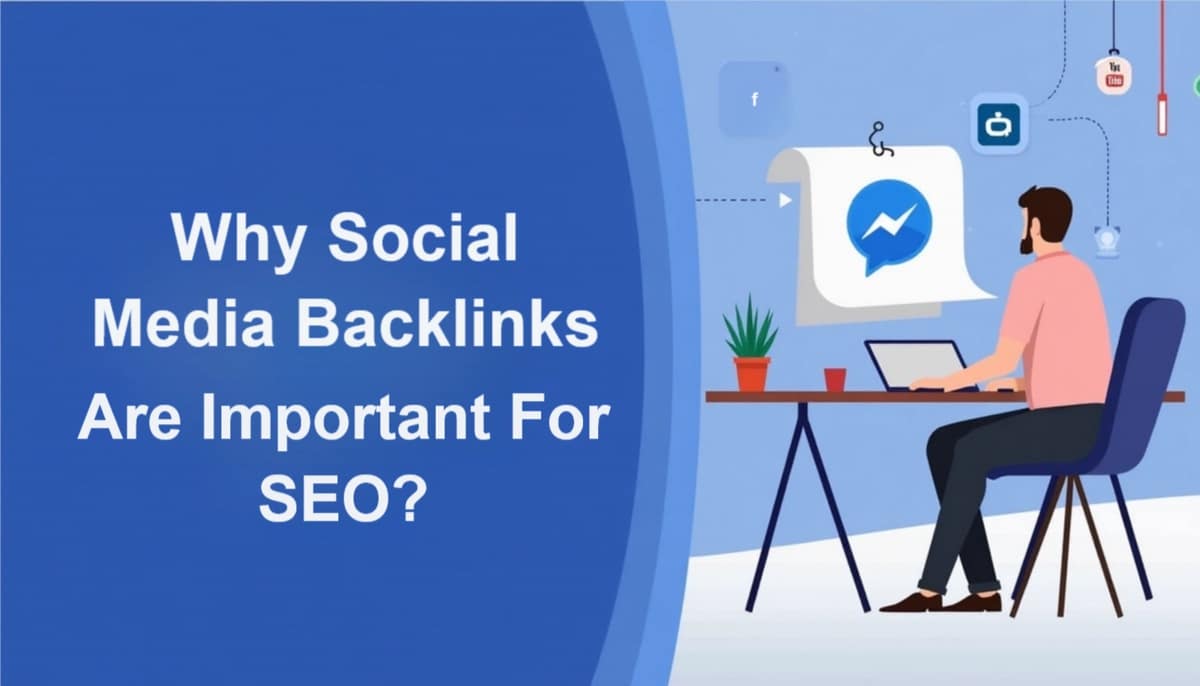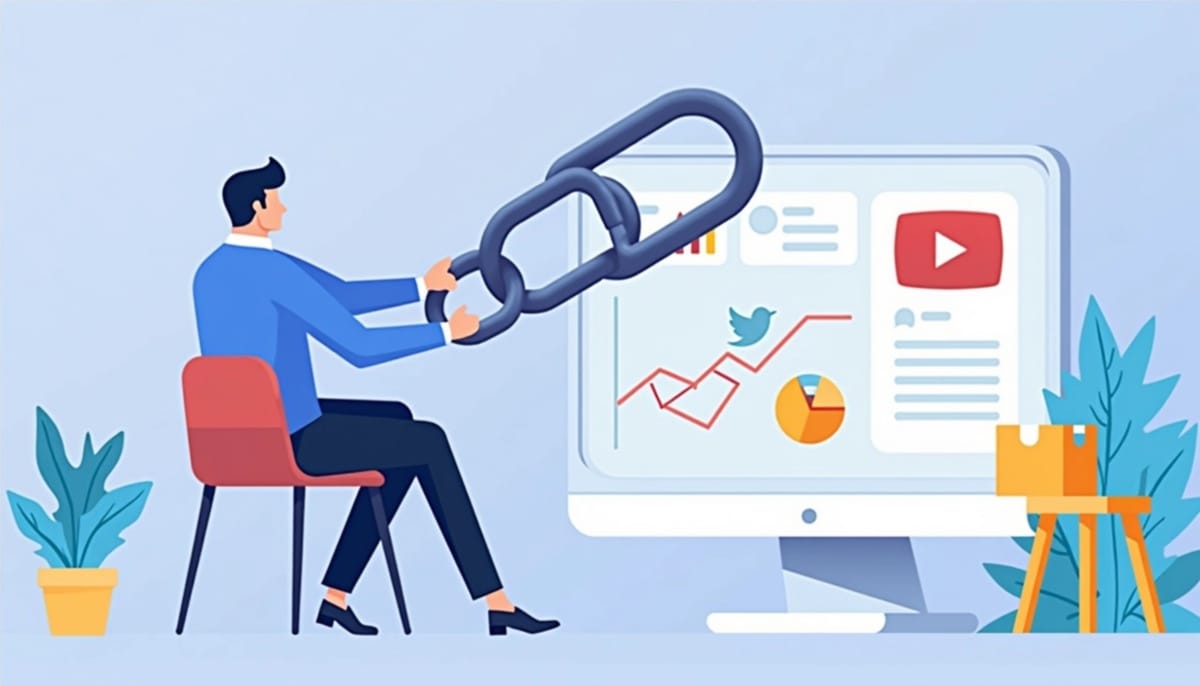Back in the day, backlinks meant guest posts and link farms. Now, social networks are chock-full of chances to link back to your site. But are social media backlinks actually worth your time? Let’s dive in, keep it simple, and maybe bust a myth or two along the way.
What Are Social Media Backlinks?
At its core, a social media backlink is any hyperlink on a social platform—Facebook, Twitter, LinkedIn, Pinterest, Reddit—that points back to your website. You’ll see them in:
- Profile bios
- Post captions and comments
- Shared articles and pins
- Group discussions and stories.
These links differ from traditional editorial backlinks because they originate on platforms designed for conversation, not for SEO hustle.
Types of Backlinks Social Media
You might be wondering, “So, what kind of links am I dealing with?” Here’s the rundown:
- Direct Post Links: Clicking a link in a tweet or LinkedIn post.
- Profile/Bio Links: Your one chance to put a clickable URL in your Instagram or TikTok bio.
- Content Shares: When someone else shares your blog post or landing page.
- User-Generated Links: Reviews, testimonials, or comments linking to your site.
Remember, most of these are “Nofollow,” meaning they don’t pass traditional link equity. But they still drive referral traffic and social signals.
Advantages and Disadvantages
When you weigh social backlinks, you’ll find they come with ups and downs. Let’s break it down so you know exactly what you’re getting into.
Advantages
- Low Barrier to Entry: You control your own profiles and posts. It’s easy to add links, even for a fresh startup.
- Instant Brand Visibility: Five billion people use social media daily, spending over two hours each. A single post can reach huge audiences fast.
- Referral Traffic and Engagement: Viral content on Reddit or Twitter can drive bursts of highly engaged visitors. These users often stick around longer than organic search traffic.
- Content Amplification: Each like, share, or comment increases algorithmic reach, potentially triggering a snowball effect of further shares.
- Cost-Effective: No ad budget needed—just your time and creativity. It’s hard to beat free eyeballs when budgets are tight.
Disadvantages
- Mostly “Nofollow” Links: Because they’re typically flagged with rel=”Nofollow”, they don’t pass SEO link equity the way editorial links do.
- Ephemeral Lifespan: Social feeds move fast. Your post might peak in visibility within hours, then vanish beneath newer content.
- Risk of Over-Spamming: Drop too many links and you’ll alienate your audience—or get shadow-banned on platforms like Reddit.
- Algorithm Dependency: Platform algorithm changes can tank your reach overnight, leaving you scrambling for alternatives.
- Time-Consuming: Crafting posts that spark engagement, then moderating comments and DMs, demands consistent effort. If you’re not careful, it can eat the whole day.
Balancing these pros and cons is key. Use social backlinks for traffic surges and brand reach, but don’t rely on them as your sole SEO tactic.
Why Do Social Media Backlinks Matter for SEO?

Here’s where it gets interesting. Google has said Nofollow links don’t directly factor into rankings. Yet, time and again, we see spikes in traffic—and sometimes in rank—after major social buzz. Why? A few reasons:
- Referral Traffic: A viral Reddit post can send thousands of visitors in an hour.
- Content Discovery: Journalists and bloggers mine social feeds for sources and then link on their sites.
- Temporary SERP Boosts: According to a SEMrush roundup, social signals can give low-competition pages a short-lived bump in Google’s search results.
So yeah, they might not be the core of your SEO strategy—but shrugging them off entirely? That’s just lazy.
Beyond Rankings: Traffic and Brand Equity
SEO is great, but let’s face it: clicks are what pay the bills. Social media backlinks shine when you want:
- Immediate Visibility: A tweet with your link can appear in hundreds of feeds within minutes.
- Targeted Audiences: B2B folks hang out on LinkedIn; Gen Z on TikTok. Place your backlinks where your crowd lurks.
- Cost-Effective Promotion: No ad spend required if you’re smart about posting—and hey, free is always nice.
In my experience, a well-timed LinkedIn article with a link to a whitepaper can yield more qualified leads than a month of paid ads. Don’t take my word for it—give it a try.
Myth-Busting: Are Social Backlinks Useless?
Heard the refrain, “Social media links don’t count for SEO”? Sure. But that doesn’t make them useless. Let’s break it down:
- Myth: “They’re all Nofollow, so they’re worthless.” Reality: They still drive clicks and amplify content. Plus, some platforms (rarely) do allow Dofollow links in profiles.
- Myth: “They clutter my feed.” Reality: Only if you spam. Thoughtful links add value and spark conversations.
- Myth: “I can ignore them.” Reality: If you ignore half the internet, you’re missing a lot.
So next time someone tells you social backlinks are “useless,” just smile and nod—then go post that killer infographic on Pinterest anyway.
Top Platforms for Social Media Backlinks
Not all networks are created equal. Here’s where to focus:
- Facebook: Profile links, page posts, groups, and event descriptions.
- Twitter (X): Tweets, bio, pinned tweet.
- LinkedIn: Articles, posts, profile “Featured” section.
- Pinterest: Pins and boards—especially effective for ecommerce and blogs.
- Reddit: Subreddit posts and comments (be subtle or you’ll get banned).
- Instagram: Bio link, stories with swipe-up (for accounts over 10K followers).
- Quora: Answers linking back to in-depth articles.
Each platform has its own quirks—so adapt your style and tone accordingly.
Social Media Backlinks Checker Is Important
Building links is one thing; measuring them is another. Try this simple approach:
- Use UTM Parameters: Append ?utm_source=twitter&utm_medium=social&utm_campaign=blogpost to every URL. That way, Google Analytics will tell you exactly which platform—and even which specific post—sent the traffic.
- Set Up Goals in Google Analytics: Track downloads, sign-ups, or contact form submissions that result from social traffic.
- Employ a Social Listening Tool: Tools like Mention or Sprout Social can alert you when someone mentions your URL—handy for spotting untagged shares.
Tracking gives you context. If your Facebook group drove 200 clicks but zero leads, you know to refine your approach.

Best Practices—and Pitfalls to Avoid
You might “just drop a link,” but that’s lazy. Instead:
- Write a Narrative: A short story or question hooks readers.
- Provide Clear Value: Why should someone click?
- Mix Up Formats: Images, videos, polls—links in captions still work.
- Engage—Don’t Spam: Answer comments, ask follow-up questions.
- Don’t Over-Optimize: Avoid the same exact anchor text everywhere.
On the flip side, if you drop links in every single comment, expect to be ghosted—or worse, shadow-banned.
Real-Life Example: HubSpot’s LinkedIn Play
HubSpot regularly publishes data-driven posts on LinkedIn with “read more” links back to their blog. Guess what happens? They get:
- Thousands of targeted clicks.
- Hundreds of comments that boost algorithmic reach.
- Secondary links when industry influencers reshare their posts.
Could you do the same? Probably—if you have a solid blog and give away genuinely useful info.
11 Social Links You Need to Build
Ready to get tactical? Here are 11 must-have social media backlinks that can broaden your reach and drive traffic:
- LinkedIn Profile and Articles: Include your site in your “Contact Info” and drop links in long-form posts.
- Facebook Page Posts and Bios: Add links in the website field on your page and in posts, images, and event descriptions.
- Twitter (X) Tweets and Bio: Pin a tweet for your latest blog post, and add your URL to your profile bio.
- Pinterest Pins and Boards: Great for visual content—directly link infographics or blog posts in each pin.
- Instagram Bio and Stories: One bio link and a swipe-up in Stories (for accounts with more than 10K followers).
- YouTube Video Descriptions: Include your website link in the first two lines of each video description.
- Reddit Subreddit Posts and Comments: Provide value first, then (if applicable) share your link. No blatant self-promo.
- Quora Answers: Give a detailed answer and reference your blog or whitepaper for further details.
- Medium Articles: Republish or recap blog content on Medium, with canonical link back to your site.
- TikTok Profile & Video Captions: Place your link in your profile, and in the videos, use a CTA to refer to (or show) your URL.
- Snapchat Snap Links: If you’re running a promotion or link you can use Swipe Up to send users right to your landing page or blog post.
Final Thoughts
Building out these social backlinks gives you multiple touchpoints across the web. Each one may not pass direct SEO juice, but collectively they drive traffic, build brand mention, and—most importantly—connect you with your audience.
At the end of the day, social media backlinks are one spoke on your SEO wheel. You still need high-quality editorial links, on-page optimization, and killer content.
Want to add something to this post? Join the discussion on Facebook, X (Twitter), or LinkedIn.
What Is Link Bait? Discover how it can help you rank your blog in search results with examples and ideas.
Sources
- www.seofocuspoint.com/what-are-social-media-backlinks/
- www.seochatter.com/what-are-social-media-backlinks/
- www.searchlogistics.com/learn/seo/link-building/social-media-backlinks/
- www.linkbuilder.io/social-backlinks/
- www.serpninja.io/blog/social-backlinks/
All images are Created with AI



Editorial Links That Skyrocket SEO: Proven Ways to Earn Authority From Top Domains
Infographic Link Building: The Scalable SEO Strategy You’re Probably Overlooking